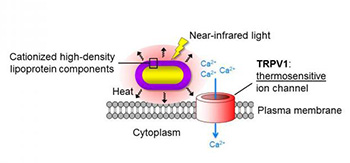
Under near-infrared light, gold nanorods heat intact nerve cells without damaging the membrane. Credit: Kyoto University's Institute for Integrated Cell-Material Sciences
A group of scientists from Kyoto University, Japan, have reportedly developed a method to create photoresponsive gold nanorods that can activate a specific pain receptor on a neuron’s cell membrane. The pain receptor is said to become desensitized after repeated activation, resulting in pain relief (Angew. Chem. Int. Ed., doi: 10.1002/anie.201505534). According to the researchers, the technology could lead to therapies that ease intractable pain, including cancer-related pain, and the platform could be useful for other phototherapeutic approaches.
The researchers reportedly coated gold nanorods with a cationic protein/lipid complex. The purpose of adding the lipoprotein was to allow the nanorods to “stick” to a specific pain receptor called transient receptor potential vanilloid type 1 (TRPV1), leaving the rest of the cell membrane untouched. The researchers report that when they applied near-infrared (IR) light to the area with the lipoprotein-coated gold nanorods, the nanorods heated up, in turn warming the TRPV1, which activates the receptor.
When activated, the TRPV1 receptor is like an open door, allowing calcium ions to cross the membrane into the nerve cell. The researchers claim that prolonged and repeated activation of TRPV1 leads to desensitization of the pain receptor, which translates to pain relief. The gold nanorods are not bioreactive, according to the scientists, which means they can be present in the body for long periods of time.
Similar methods targeting TRPV1 have been proposed—one of these methods uses magnetic nanoparticles—but they require genetic modification of the targeted nerve cells. Tatsuya Murakami, principal investigator of this study, says: “Local injection of our gold nanorods might enable repetitive and on-demand treatment for people experiencing intractable pain because prior genetic engineering of the target cells is unnecessary.” Murakami adds that his team’s gold nanorods generate heat and activate TRPV1 1,000 times more efficiently than the genetically modified magnetic nanoparticles.
